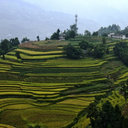Microcystin-LR induced oxidative stress and ultrastructural alterations in mesophyll cells of submerged macrophyte Vallisneria natans (Lour.) Hara.
Keywords
Abstract
Microcystins produced by cyanobacteria in the aquatic environment are a potential risk to aquatic plants. In the present study, the uptake of microcystin-LR (MC-LR) and related physiological and biochemical effects on Vallisneria natans (Lour.) Hara were investigated at concentrations of 0.1-25.0 μg L(-1). Results showed that O(2)(-) intensity was significantly induced at 1.0 μg L(-1) and reached a maximum level at 5.0 μg L(-1). Superoxide dismutase (SOD) and peroxidase (POD) were induced with increasing MC-LR concentrations as an antioxidant response. Catalase (CAT) was significantly induced while GSH/GSSG (reduced/oxidized glutathione) ratio was significantly reduced at 0.1 μg L(-1). The induction of glutathione S-transferase (GST) and inhibition of GSH revealed that GSH was involved in the detoxification of MC-LR in plants. Oxidative damage was evidenced by the significant increase of malondialdehyde content at 1.0 μg L(-1). A pigment pattern change and a series of significant ultrastructural alterations were also observed due to MC-LR exposure. The lowest non-effect concentration of MC-LR for V. natans at the subcellular and molecular level is around 0.5 μg L(-1). These results imply that even at relatively low MC-LR concentrations the aquatic plants may still suffer a negative ecological impact.



